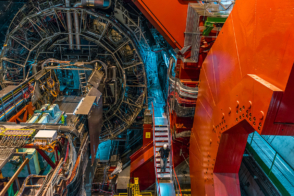A report from the ALICE experiment

A new measurement by the ALICE collaboration has demonstrated for the first time that jets become narrower after “quenching” in quark–gluon plasma (QGP). RHIC and LHC data show that the QGP behaves like a strongly-coupled liquid with very low viscosity, but it is an open question how this arises from the asymptotic limit of weakly-coupled quarks and gluons at short lengths. The new results provide quantitative new insights into the hot and dense medium created in heavy-ion collisions and how it modifies the substructure of jets and dissipates part of their energy.
An important property of the QGP is its ability to “resolve” nearby partons as effectively independent colour charges above the medium’s characteristic resolution scale – a parameter that is very poorly predicted by theory, but thought to be in the vicinity of a femtometre or less. In recent years, jet quenching has been proposed to determine this scale. Jets originate from a single quark or gluon that showers into more partons, either by radiating a gluon or splitting into a quark–antiquark pair. When a jet moves through the medium, each individual splitting results in two distinct colour charges that, depending on their angular separation and the medium’s resolution length, can interact as one coherent object or two independent charges. At the LHC, we can put our understanding of this resolution scale to test using special measurements of the angular structure of jets. This allows us to test whether wider jets are more likely to be resolved.
ALICE “groomed” jets using track clustering

To identify the relevant two-prong splittings, ALICE “groomed” jets using track clustering. The algorithm reclusters and unwinds the jet shower to find the first parton splitting satisfying a grooming condition (figure 1). The excellent tracking resolution in ALICE allows for very precise measurements of jet substructure even at small angular distance scales. The angular width of the jet was found to be significantly modified in Pb–Pb compared to pp collisions (figure 2). In particular, wider splittings are suppressed in Pb–Pb compared to pp collisions, demonstrating that the interaction of jets with the QGP filters out wide jets.
This measurement is the first of its kind to be fully corrected for large background effects, allowing direct quantitative comparisons with theoretical calculations of jet quenching. Most theoretical models describe the general narrowing trend seen in the data, despite the different implementations of jet-medium interactions. The data is consistent with models implementing an incoherent interaction in which the medium resolves the splittings (Pablos, Lres = 0). Interestingly, however, another calculation demonstrates this narrowing effect with a fully coherent interaction, in which the jet splittings are not resolved, but by modifying the initial quark and gluon fractions (Yuan, quark). While the precision of the data currently precludes a precise extraction of the medium’s resolving power within a given model, the measurement places quantitative constraints on medium properties, and demonstrates for the first time a direct modification to the angular structure of jets in heavy-ion collisions. This opens the door to increasingly precise measurements with the high-precision data anticipated in LHC Run 3.
Further reading
ALICE Collaboration 2021 arXiv:2107.12984.





